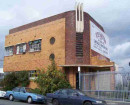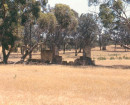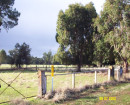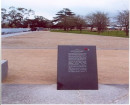SACRED HEART CATHOLIC COMPLEX
26 ROBERTSON STREET, CASTERTON, GLENELG SHIRE
-
Add to tour
You must log in to do that.
-
Share
-
Shortlist place
You must log in to do that.
- Download report


Statement of Significance
What is Significant?
The Sacred Heart Catholic Complex is located in Robertson Street, on "Toorak Hill" over looking the township of Casterton. The complex, which relates specifically to the Parish (or Mission) of Casterton includes the Sacred Heart Church , the Parish Hall, the Presbytery and the archaeological site of the Sacred Heart Convent and the remains of once substantial gardens. The first building on the site was the Presbytery, constructed for Father Marshall in 1879-80. The Presbytery is a symmetrical brick residence, with the typical central passage and four principal rooms. The facade is typical with a central door and double hung sash windows on either side. The roof is a simple hip. Originally of corrugated iron, it is now clad in modern Zincalume. The original verandah, of corrugated iron with fine timber posts stretched across the facade, has been replaced by a heavy brick pier and corrugated iron structure which crosses the facade and continues around the side of the building. An extension at the rear, continued in similar brick, was added in the early 1920s by Fr. Evans. No architect or builder has been found for the Presbytery. It is generally in good condition and retains a high degree of integrity externally (other than the modern verandah). The interiors have not been inspected.
The next building constructed was the Church, in 1886, designed by architects Tappin and Gilbert. The original church is still evident, as it comprised the nave and a small square porch located to the west side of the southern end (originally designed to become a spire or tower). In 1918, further works were completed, including the addition of the polygonal apse at the northern end, with a vestry and side chapel housed in east and west transcepts. The Sacred Heart Church as it stands today is a red brick building laid in stretcher-bond pattern with moulded and rendered detailing, now painted white. It is raised on a projecting bluestone plinth with a corbelled end. The roofs are all slate with iron ridge capping on the original nave. Each of the gable ends have stone cappings with a St. Andrew's cross affixed to the highest point. The gables have stepped buttresses at the corners. The nave has five dormer gabled vents projecting on each side of the roof. Mature Pinus radiata (Monterey Pines), dating from the late nineteenth century stand to the east of the church and there are small gardens on the south side of the church. Bitumen car parking areas flank the east and west sides of the church. The church is a fine example of a brick church in the Gothic Revival style. The Church is generally in excellent condition and retains an excellent degree of integrity to the 1896 and 1918 periods.
The Parish Hall, located immediately to the east of the church is rectangular in plan, built of bricks typical of Branxholme and Portland clays, and has a gabled roof clad in corrugated iron. There is a small gabled porch at the centre of the east wall and a gabled wing at the south end of the west side. The bricks are laid in alternating courses of stretcher and header. The whole hall is raised on a bluestone plinth which is deepest on the north side. The asphalt of the carpark is covering the bottom of the bluestone plinth. The main section of the hall has arched double hung sash windows, subdivided into four panes. The timber-framed windows have a stone sill and a stretcher brick arch above them. The hall was designed by architect W.T.Killeen. A large two storey brick Convent in the Gothic style once stood on the edge of the hill overlooking the Glenelg River valley and the town of Casterton. The Convent, constructed in 1906 by architectural firm Clegg and Miller, was built to house the Sisters of Mercy, who arrived in the town in the early years of the twentieth century, and began to educate at the primary and secondary levels. The schools proved so popular that within a two year period their premises expanded from one rented house to four. The Convent of the Sisters of Mercy was demolished in the mid 1980s after being declared to be structurally unsound. The site may have archaeological potential.
How is it Significant?
The Catholic Complex is of historical, social and architectural significance to the Glenelg Shire (and the State of Victoria??).
Why is it Significant?
The Sacred Heart Catholic Complex is of architectural significance, as the church is an example of the work of the important architectural firm, Tappin and Gilbert, who designed, amongst others, St. Paul's Cathedral in Melbourne, The Abbotsford Convent and the Melbourne Gas Company's offices. The Hall was designed by local architect W.T.Killeen, and the contrast in style and sophistication between the two is an interesting juxtaposition. The church demonstrates architectural significance for its use of the Gothic revival style to express religious values, for the range and quality of its interiors, including the altar, font, many memorials, other memorial donated fittings, and as a comparison with the churches of other denominations in Casterton. The Presbytery is of architectural significance as a typical representative example of a later nineteenth century Presbytery, using local materials (hand made bricks from the banks of the Glenelg River). The Convent of the Sisters of Mercy, now demolished, strongly demonstrated religious values expressed architecturally through the use of gothic arches, materials and for the range of materials and fixtures internally and externally. The architectural firm of Clegg and Miller is also of some interest, they being the same firm who were employed to undertake works on Her Majesty's Theatre in Melbourne around the same time the convent was built, in 1906.
Sacred Heart Catholic Complex is of historical significance as the most substantial complex, and certainly the only one with its own convent, built in the district. The complex reflects the rise of Casterton, the township from the 1880s onwards, succeeding Sandford as the centre of the district, as the whole mission changed focus from Sandford to Casterton, and the much earlier St. John's Catholic Church at Sandford went into some demise. It also reflects the rise of the Catholic Church in the area, much later than some other churches, starting in 1880 when the Presbytery was built, and continuing to invest large amounts of money in property and infrastructure, evidenced by the additions to the church, the construction of the convent and hall, and the planting out of gardens around the complex. It is clear that the arrival of the four Sisters of Mercy in the very early 1900s was a turning point in the fortunes of the church, as the education they provided was vastly popular and co-incided with beginnings of consolidation. The arrival of Fr. Lowham in 1909 continued this development and consolidation. From a historical perspective, it is interesting to note that the donation of land, materials, memorials and furnishings did not come from the most important and affluent members of society, representing large pastoralists, but rather, represents the mainly Irish Catholic selectors who came to the area in the 1860s, 1870s, 1880s. This draws a strong comparison with other early churches whose main benefactors were the important major pastoralists. The complex as a whole is historically significant as the expression of the role and position of the Catholic Church and its congregation in the community for over one hundred and fifty years.
-
-
SACRED HEART CATHOLIC COMPLEX - Usage/Former Usage
Continues its original uses as a Church and Parish Hall
SACRED HEART CATHOLIC COMPLEX - Physical Description 1
The Sacred Heart Catholic Complex comprises the church itself, the Church Hall, the Presbytery and the archaeological site of the Sacred Heart Convent. This complex is located on Robertson Street, on top of Toorak Hill overlooking the township of Casterton. The church does not address Robertson Street, but rather looks north east towards the main Parish Hall.
The Sacred Heart Church is a red brick building laid in stretcher-bond pattern with moulded and rendered detailing, now painted white. It is raised on a projecting bluestone plinth with a corbelled end. The roofs are all slate with iron ridge capping on the original nave. Each of the gable ends have stone cappings with a St. Andrew's cross affixed to the highest point. The gables have stepped buttresses at the corners. The nave has five dormer gabled vents projecting on each side of the roof. Mature Pinus radiata (Monterey Pines), dating from the late nineteenth century stand to the east of the church and there are small gardens on the south side of the church. Bitumen car parking areas flank the east and west sides of the church.
The church has pointed saracenic arched doors, made of timber, which have two rectangular leaves with a single drop arch above. The door surrounds are rendered with small quoins and a raised triangular arch moulding above. The north wall has an arched door on each side of the wall leading into the entrance porch. The doors have a raised gable motif with a fleur-de-lis at the apex. The door and details of the east side is larger than the door on the west side of the wall. Steps carved from granite from Wando Vale lead down with metal handrails.
The narthex at the southern end of the nave is asymmetrical in design, built in two separate sections (1896 and 1918). The west side has a gable roof; the east section of the narthex is larger than the west and square with a pyramidal roof and a small arched window on the west wall. A confessional with a flat roof has been added to the building at the corner of the west side of the narthex and the first bay of the nave. It has a small window with a square pane and an arched pane of glass. This addition does not have the same level of detailing as the rest of the church and is a recent addition. It was added after the removal of the choir balcony At the centre of the southern wall there is a tripartite stained glass window. The central window is taller than the side panels. At the apex of the gable, there is a raised vent. Below the windows, there are further vents, decorated with rendered detail.
Each bay of the nave has a pair of lancet windows, with stepped buttresses between each bay and an intermediate cornice which is continued around the building. The windows have rendered reveals, sills and small quoins, not painted white. Above each window there is a raised arch moulding. The windows are subdivided by leadlight in a diaper pattern. There is a pointed saracenic arched door in the second bay of the east wall of the nave, with triangular arch mouldings above. A concrete (?) ramp has been added to allow wheelchair access to the doors on this side of the church.
The church has a polygonal apse at the southern end with east and west gabled transepts. The apse has windows on two walls with pictorial stained glass. The stained glass windows are of excellent quality. The west transept has a window on the west and south walls. The tradition of pointed sascenic arched doors with triangular arch moulding is continued throughout the church. The east transept has two windows on the south and a pair of windows on the east gable wall.
A Granite Plaque on the north wall states: "THIS CHURCH BEGUN BY / FATHER J. MARSHALL/ 1886,/ COMPLETED BY / REV J.P. LOWHAM P.P/ SOLEMNLY DEDICATED BY/ MOST REV. D FOLEY D.D/ LORD BISHOP OF BALLARAT/ JUNE 30TH 1918."
The church has a scissor truss roof structure which is exposed on the inner ceiling. The ceiling is lined with dark-stained timber in a diagonal pattern, in square panels. The beams on the roof are supported by corbelled blocks at each bay.
There are timber church pews in the nave and part of the side chapel. A portion of the east transept is enclosed as a vestry. An altar table, also of timber stands at the centre of the apse.
A number of donated memorials exist within the church, including: a small fine marble baptismal font, donated by Mrs. Eliza Casey in memory of her sons Bernard and Patrick. In the apse, the two stained glass windows are located, one depicts the Assumption of Blessed Virgin Mary (in memory of Mr and Mrs Jeremiah Lehane of Bahgallah), the other is of Sacred Heart and St. Margaret Mary (in memory of Mr and Mrs. Patrick O'Connell of Bahgallah). Other memorial fittings include a Cedar Vestment Press, donated by Messrs LJ and EP O'Connell in memory of Mr and Mrs ET O'Connell; Marble Altar rails, erected in memory of James Killeen who died 30th October 1873; Stations of the Cross, erected in memory of Eliza Killeen who died 31st October 1939; a variety of statues, sets of Gothic Vestments and black cope, other vestments, collection and communion plates and other memorial items. The Church Bell, cast in Melbourne by John Danks and Co. in 1917 also survives.
The Sacred Heart Presbytery is located some distance east of the main church. The Presbytery is a typical symmetrical building constructed of locally made red brick. The facade is symmetrical with a central door with sidelights, and on either side of the door are double hung sash windows. A mid twentieth century brick and corrugated iron verandah has replaced the original, and detracts from the symmetrical facade of the building. The building has a hipped roof clad in modern zincalume.
The west elevation has 3 or 4 double hung sash windows with a shallow arched top. The windows have shallow arches of stretcher bricks above. There is a metal rain water tank on the west side of the building. There are two chimneys on the roof, probably serving four fire places in the principal four front rooms. To the west of the house there is a brick outbuilding (garage) with a corrugated metal roof. It has a double hung sash window on the west wall. The Presbytery was extended and altered slightly in the 1920s by Father E.V Ryan. Very little of the original extensive garden remains around the Presbytery, but an Araucaria bidwillii (Bunya Bunya) survives a short distance in front of the facade of the building, as do several Pinus, some distance from the Presbytery.
The Sacred Heart Church Hall is situated to the immediate southwest of the church. The hall is rectangular in plan and has a gabled roof clad in corrugated iron. It is aligned north-south. There is a small gabled porch at the centre of the east wall and a gabled wing at the south end of the west side. The main hall measures approximately 20-25 metres by 7-8 metres. The hall is constructed of bricks which have the characteristic colour (dark blue/red/brown) of the Branxholme clays. The same bricks were used to extend Rosebank, the residence of Charles Koch at Sandford at about the same time. The bricks are laid in alternating courses of stretcher and header. The whole hall is raised on a bluestone plinth which is deepest on the north side. The asphalt of the carpark is covering the bottom of the bluestone plinth.
The main section of the hall has arched double hung sash windows, subdivided into four panes. The timber-framed windows have a stone sill and a stretcher brick arch above them. The east wall has a door and two windows on the north side of the porch. The rectangular timber door of one leaf has a window above with a rectangular pane and a small arched pane above. On the north wall of the porch, there is a small metal vent and a timber door, similar to the door on the east wall. The door, now painted burgundy, has a stone lintel above and a timber frame, painted white. Both doors have a set of stairs, of modern red brick and concrete with steel balustrades, which have been added. The gabled end on the porch has a small version of the arched windows in the main hall. The north wall of the hall has eight metal vents in three rows (2, 3, 3) at the centre of the wall.
There is a brick chimney with fine detailing in the centre of the west wall. The bricks of the west wing of the building are placed in stretcher bond courses, indicating it was built later. The colouring of the bricks is quite similar to the original. There are two rectangular double hung sash windows on the south wall of the west wing. There are metal vents on the south and west walls. There is a water tank raised on a metal and timber stand (approximately 3 metres high) on the west wall of the wing. There is a chimney on the north wall of the west wing. The length of the hall was extended in the early twentieth century, and the small room to the southern side was also added.SACRED HEART CATHOLIC COMPLEX - Physical Conditions
Generally very good, some evidence of rising damp on the hall where the bitumen covers the bluestone plinth.
SACRED HEART CATHOLIC COMPLEX - Historical Australian Themes
Theme 8 Developing Australia's cultural life
8.6 Worshipping
8.6.1 Worshipping together
8.6.3 Founding Australian religious institutions
8.6.4 Making places for worshipHeritage Study and Grading
Glenelg - Glenelg Shire Heritage Study Part One
Author: Carlotta Kellaway, David Rhodes Mandy Jean
Year: 2002
Grading:Glenelg - Glenelg Heritage Study Stage Two (a)
Author: Heritage Matters
Year: 2006
Grading:
-
-
-
-
-
CASTERTON RAILWAY STATION
 Victorian Heritage Register H1663
Victorian Heritage Register H1663 -
STOCK SELLING RING
 Victorian Heritage Register H0314
Victorian Heritage Register H0314 -
TOWN HALL
 Southern Grampians Shire
Southern Grampians Shire
-
177 Fenwick Street
 Yarra City
Yarra City -
19 Cambridge Street
 Yarra City
Yarra City -
2 Derby Street
 Yarra City
Yarra City
-
-











